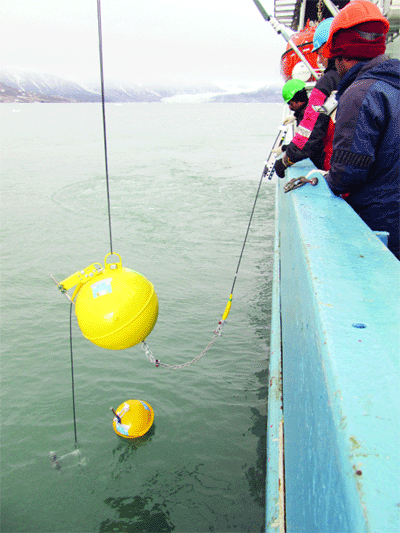Indian scientists are out to unravel the elusive mystery behind monsoon, which plays a significant role in determining the country’s economic and social growth.
Though the subject of monsoon has been a topic of study by the climatologists for quite sometime, this unusual weather phenomenon is yet to provide any insight into its behaviour or patterns.
This time, the scientists of the country has selected an unusual spot to zero in on the character of the monsoon. Scientists of the National Centre for Antarctic and Ocean Research, Goa, succeeded in installing a multi sensor moored observatory in the Arctic region on July 23, 2014. The observatory has been anchored at a spot 1100 km away from the North Pole and at a depth of 192 metres inside the earth.
“It has been anchored at a fjord (glacier valley) near Kongsfjorden, near Norway and is an established reference site for studying Arctic marine studies,” Dr MA Atmanand, Director, National Institute of Ocean Technology (NIOT), Chennai, told The Pioneer. It was Atmanad who led the team of engineers which designed and developed the observatory.
The observatory which has ten state-of-the-art oceanographic sensors will collect data on seawater temperature, salinity, ocean current and other vital parameters of the fjord, according to Dr S Rajan, Director NCAOR, Goa. “This is a joint effort by NIOT and the NCAOR. We told the NIOT scientists about our requirements and they designed and built the observatory,” said Dr Rajan.
Every year from March to September, a team of NCAOR scientists will fly to Kongsfjorden to collect the data from the observatory. “During the remaining period, the observatory will be underneath thick snow and we will not be able to get any information,” said Rajan.
Why Arctic, of all the places to study the Indian MonsoonIJ Both Atmanand and Rajan point out that there is a tele-link between the monsoon and the Arctic. “Many studies have been held on the correlation between atmosphere and the monsoon. Our scientists have also studied the impact of variations in the ocean on monsoon. Most of the oceans are inter connected. Our objective is to find out and establish the link between monsoon and the polar regions. This is expected to help in forecasting the monsoon without variations,” said Rajan.
Dr Rajan pointed out that previous studies have established six of the total 16 variables which influence the monsoon. “If we get to know the remaining ten variables, it is going to help the Indian economy as we will be mastering the pattern of monsoon,” he said.
In addition to monsoon studies, the data from the observatory would help to understand the role of polar regions in climate change as well as variability, said the NCAOR Director. “There are many microbial organisms in the fjord which are tolerant to sea water. The studies will throw more light into such organisms and in the long run we are sure to get lot of information about new organisms,” said Rajan.
The observatory has been named IndARC. India has a presence in the Arctic region as observer since 2007 and with installation of IndARC, the country is graduating to the level of serious player in the region.
























